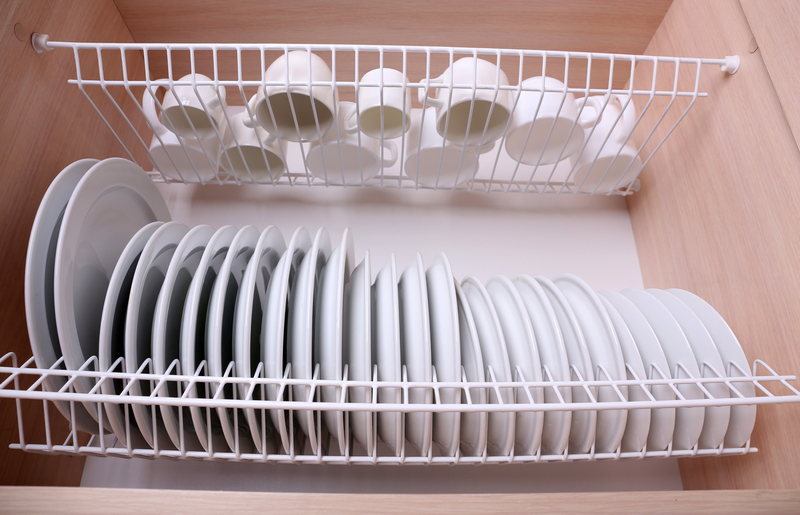How to Design a Sustainable House Cleaning Regimen
Posted on 04/06/2025
How to Design a Sustainable House Cleaning Regimen
A sustainable house cleaning regimen is not just about keeping your home spotless; it's a conscious lifestyle choice that supports the health of your household, the well-being of cleaning staff, and the preservation of our planet. In today's world, where environmental concerns shape our daily activities, learning how to design a sustainable house cleaning regimen is crucial for anyone who values cleanliness and responsibility.

Why Opt for a Sustainable Cleaning Routine?
Switching to eco-friendly cleaning methods offers benefits for your health, your finances, and the planet. Here are the key reasons to implement a sustainable household cleaning regimen:
- Reduced exposure to toxic chemicals in conventional cleaning products.
- Lower environmental impact by minimizing waste, water, and chemical pollution.
- Cost savings from reusable supplies and homemade cleaning solutions.
- Improved indoor air quality
- Support for ethical brands and practices
By crafting a conscious house cleaning strategy, you're investing in a cleaner, healthier world--inside and outside your home.
Essential Principles of Sustainable House Cleaning
To build a sustainable home cleaning regimen, it's important to understand the core principles that guide eco-friendly habits. Let's delve into the pillars that support a sustainable cleaning schedule:
1. Choose Eco-Friendly Cleaning Products
Not all cleaning products are created equal. Many store-bought options contain volatile organic compounds, synthetic fragrances, and harsh chemicals that linger on surfaces and in the air. Opt for green cleaning products that are:
- Biodegradable - Break down naturally without harming the environment.
- Plant-based - Made from renewable ingredients rather than petroleum derivatives.
- Non-toxic - Safe for humans and pets.
- Minimalist in packaging - Packaged in recyclable or refillable containers.
When shopping, look for certifications such as EPA Safer Choice, EcoLogo, or Green Seal. Alternatively, make your own cleaning solutions with household items like vinegar, baking soda, and castile soap.
2. Minimize Waste
Reducing waste is a cornerstone of any sustainable house cleaning routine. Consider these strategies:
- Use reusable cleaning cloths and mop heads instead of disposables.
- Repurpose old towels and t-shirts as rags.
- Buy in bulk to reduce packaging waste.
- Recycle containers whenever possible.
- Compost compostable waste, including paper towels (if chemical-free), natural sponges, and debris from plant-based cleaners.
3. Save Energy and Water
A sustainable home cleaning regimen also includes mindful use of resources:
- Clean with cold water when appropriate to lower energy consumption.
- Only run dishwashers and washing machines with full loads to maximize efficiency.
- Fix leaky faucets to prevent water waste.
- Opt for energy-efficient appliances and fans for drying surfaces.
4. Plan for Consistency and Prevention
The most eco-friendly way to keep your home clean is to prevent messes. Routine, preventative maintenance makes cleaning easier and more sustainable:
- Take shoes off when entering to reduce tracked-in dirt.
- Wipe up spills immediately to avoid the need for harsh cleaners later.
- Regularly dust and ventilate your home to reduce allergen buildup.
- Declutter regularly, which lessens dust and makes cleaning more efficient.
Steps to Develop Your Sustainable Cleaning Regimen
Ready to get started? Follow this step-by-step approach to establish an eco-conscious home cleaning routine that's effective and manageable.
Step 1: Assess Your Current Cleaning Habits
- Inventory your supplies. Examine what's under your sink or in your cleaning caddy. Identify which products are harmful and which are eco-friendly.
- Audit your tools. Do you use disposables like paper towels, plastic sponges, or single-use wipes? Consider which items can be replaced with sustainable alternatives.
- Evaluate your frequency. Are you over-cleaning? Some tasks, like vacuuming high-traffic areas, should be done regularly, but others may not need daily attention.
Step 2: Source and Transition to Green Cleaning Products
- Finish existing supplies responsibly. Use up or donate conventional products you already have to avoid unnecessary waste.
- Research and purchase eco-friendly products or ingredients for homemade cleaners.
- Check labels and look for transparency in ingredient lists.
Step 3: Set a Realistic and Consistent Cleaning Schedule
A regular house cleaning regimen enhances hygiene and reduces the need for harsh treatments.
- List weekly and monthly tasks: For example, vacuum carpets weekly, mop floors monthly, and launder linens regularly.
- Break up chores across the week to avoid burnout.
- Recruit help from household members; share the workload and teach sustainable practices to children.
Step 4: Master DIY Natural Cleaning Recipes
Homemade cleaners are a hallmark of a truly sustainable cleaning regimen. Here are a few tried-and-true recipes:
- All-Purpose Cleaner: Mix 1 part white vinegar with 1 part water, add a few drops of essential oil (like lemon or tea tree for a fresh scent). Spray on surfaces and wipe clean.
- Glass Cleaner: Combine 2 cups water, 1/4 cup white vinegar, and 1/2 teaspoon liquid castile soap. Shake and use on mirrors and windows.
- Scrubbing Paste: Mix 1/2 cup baking soda with just enough water to form a paste. Use for tubs, sinks, and stovetops.
*Always spot test new cleaners, especially on delicate surfaces.
Step 5: Upgrade to Sustainable Cleaning Tools
- Microfiber cloths (washable/reusable)
- Bamboo scrub brushes
- Reusable mop heads
- Natural sponges (cellulose or loofah)
- HEPA vacuum cleaners (improve air quality and last longer)
These sustainable tools not only last longer but also clean more effectively with less effort and fewer chemicals.
Step 6: Manage Moisture and Air Quality
A cleaner home means nothing if the air inside is compromised. Proper ventilation and humidity control prevent mold and eliminate the need for harsh cleaners. Consider:
- Opening windows regularly to circulate fresh air.
- Using exhaust fans in bathrooms and kitchens.
- Placing dehumidifiers in damp-prone areas.
- Adding air-purifying houseplants like spider plants or snake plants.
Room-by-Room Sustainable Cleaning Tips
Let's break down sustainable strategies for each main area in your home:
Kitchen
- Wipe counters with a vinegar-based cleaner.
- Use a biodegradable dish brush for washing up.
- Compost food scraps to reduce landfill waste.
- Choose a natural drain cleaner (hot water and baking soda) instead of caustic chemicals.
Bathroom
- Spray non-toxic disinfectant after every use on high-touch surfaces.
- Use a scrubbing paste for grout and tubs.
- Replace disposable wipes with washable cloths.
- Switch to eco-friendly toilet bowl tablets or cleaners.
Living Areas
- Vacuum with a HEPA filter vacuum to trap dust and allergens.
- Use dry dusting with microfiber cloths for shelves and electronics.
- Maintain regular air ventilation.
- Spot-clean stains immediately with natural soap and water.
Bedrooms
- Wash bedding in cold water with green detergent.
- Air out mattresses and pillows weekly.
- Vacuum carpets and rugs regularly.
- Declutter for easier cleaning and less dust accumulation.
Laundry
- Switch to a concentrated, plant-based laundry detergent.
- Air-dry where possible to save energy.
- Wash full loads and avoid hot water cycles if not necessary.
Advanced Sustainable Cleaning Practices
Greywater Reuse
- If feasible, collect runoff water from rinsing vegetables or lightly used bathroom sink water to mop floors or flush toilets.
Zero-Waste Challenges
- Try a zero-waste month: Monitor everything you throw away during cleaning and aim to reduce, reuse, or replace those items.
Support Eco-Friendly Brands and Services
- Choose sustainable cleaning services for deep cleans, moving, or rentals.
- Encourage local businesses and support green startups in the cleaning industry.

Frequently Asked Questions on Sustainable House Cleaning
Can a Sustainable Cleaning Regimen Kill Germs Effectively?
Absolutely. Many natural ingredients, such as vinegar, hydrogen peroxide, and essential oils, are proven disinfectants. For high-touch surfaces, use a combination of soap and hot water for thorough cleaning and follow up with a natural sanitizer if needed.
Is Eco-Friendly Cleaning More Expensive?
Initially, sustainable cleaning products may seem pricier, but over time you save by making your own cleaners, buying in bulk, and investing in reusable supplies. Moreover, better air quality and health mean potential savings on healthcare costs in the long run.
Can I Make All My Cleaning Products at Home?
Most basic cleaning tasks can be covered with DIY natural cleaners like vinegar, baking soda, lemon, and castile soap. Specialized situations (like oven cleaning or mold remediation) may require store-bought eco-friendly products.
Conclusion: Your Path to a Cleaner, Greener Home
Designing a sustainable house cleaning regimen is an act of stewardship--for your home, your health, and the environment. By choosing eco-friendly cleaning practices, reducing waste, making your own products, and maintaining a consistent cleaning schedule, you become part of the solution to global environmental challenges. Let each routine, product choice, and mindful action be a step toward a clean, sustainable, and healthy living space.
By following these tips and strategies on how to design a sustainable house cleaning regimen, you make every sweep, scrub, and wipe count for a more beautiful home and a better world.



